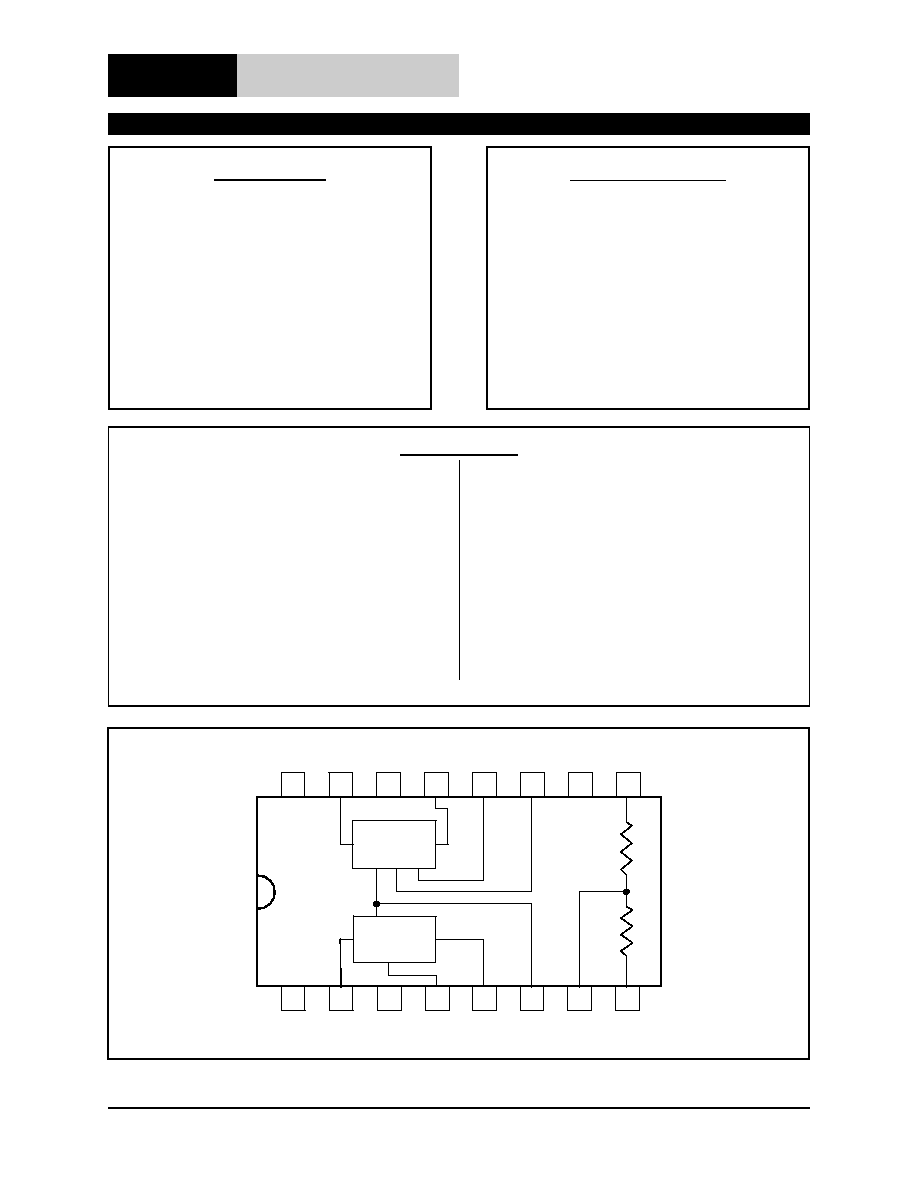 | –≠–ª–µ–∫—Ç—Ä–æ–Ω–Ω—ã–π –∫–æ–º–ø–æ–Ω–µ–Ω—Ç: THAT4315 | –°–∫–∞—á–∞—Ç—å:  PDF PDF  ZIP ZIP |

THAT Corporation; 45 Sumner Street; Milford, Massachusetts 01757-1656; USA
Tel: +1 508 478 9200; Fax: +1 508 478 0990; Web: www.thatcorp.com
Document 600065 Rev 01
T H A T
C o r p o r a t i o n
Pre-trimmed Low-voltage
Low-power Analog Engine
Æ
IC
THAT 4315S
FEATURES
∑ Pre-trimmed VCA & RMS detector
∑ Wide supply voltage range: 4.5V~16V
∑ Low supply current: 1.6 mA typ. (5V)
∑ Wide dynamic range: 118 dB as
compander
APPLICATIONS
∑ Companding noise reduction
∑
Wireless microphones
∑
Wireless instrument packs
∑
Wireless in-ear monitors
∑ Battery operated dynamics processors
∑
Compressors
∑
Limiters
∑
AGCs
∑
De-essers
Description
The THAT4315S is a single-chip Analog En-
gine
Æ
optimized for low-voltage, low-power oper-
ation. Incorporating a high-performance voltage-
controlled amplifier (VCA) and RMS-level sensor,
the
surface
mount
part
is
aimed
at
bat-
tery-operated audio applications such as wire-
less microphones, wireless instruments and
in-ear monitors. The 4315 operates from a single
supply voltage down to +4.5Vdc, drawing only
1.6mA.
This IC also works at supply voltages up to
16Vdc, making it useful in line-operated prod-
ucts as well. The VCA is pre-trimmed at wafer
stage to deliver low distortion without further ad-
justment.
The part was developed specifically for use as
a companding noise reduction system, drawing
from THAT's long history and experience with
dbx
Æ
technology for noise reduction. However,
with 11 active pins, the part is extremely flexible
and can be configured for a wide range of appli-
cations
including
single
and
multi-band
companders,
compressors,
limiters,
AGCs,
de-essers, etc.
What really sets the 4315 apart is the trans-
parent sound of its BlackmerTM VCA coupled
with its accurate true-RMS level detector. The IC
is useful in battery-powered mixers, compres-
sor/limiters, ENG devices and other portable au-
dio products.
15
2
14
3
13
4
12
5
11
6
10
7
9
8
THAT
4315S
EC-
EC+
IN
OUT
VCA
IN
CT
OUT
RMS
16
1
VCA
IN
RMS
IN
VCA
OUT
CT
NC
NC
NC
NC
EC-
RMS
OUT
EC+
VREF
NC
FILT
VCC
GND
Ra
Rb
Figure 1. THAT4315 equivalent block diagram

THAT Corporation; 45 Sumner Street; Milford, Massachusetts 01757-1656; USA
Tel: +1 508 478 9200; Fax: +1 508 478 0990; Web: www.thatcorp.com
Page 2
THAT4315S Pre-trimmed Low-voltage
Low-power Analog Engine
IC
Positive Supply Voltage (V
CC
)
+18V
Supply Current (I
CC
)
30mA
Operating Temperature Range (T
OP
)
-40 to +85 ∫C
Junction Temperature (T
J
)
-40 to +125 ∫C
Output Short-Circuit Duration
30 sec
Power Dissipation (P
D
) at T
A
=85 ∫C
400mW
Input Voltage
Supply Voltage
Storage Temperature Range (T
ST
)
-40 to +125 ∫C
Lead Temperature Range (Soldering, 10 sec)
300 ∫C
Absolute Maximum Ratings
1
Power Supply
Positive Supply Voltage
V
CC
Referenced to GND
+4.5
-
+16
V
Supply Current
I
CC
No Signal
V
CC
=+5 V
1.6
2.5
mA
V
CC
=+15 V
2.3
3.5
mA
Voltage Controlled Amplifier (VCA)
Max. I/O Signal Current
i
IN(VCA)
+ i
OUT(VCA)
V
CC
= +5 V
500
µA
peak
V
CC
= +15 V
1
mA
peak
VCA Gain Range
-50
+50
dB
Gain at 0V Control
G
0
E
C+
= E
C-
= 0V
-1.0
0
+1.0
dB
Gain-Control Constant
E
C+
/Gain (dB)
-40 dB to +40 dB
-
6.0
-
mV/dB
Gain-Control Tempco
E
C
/
T
CHIP
Ref T
CHIP
=27∫C
-
+0.33
-
%/∫C
Output Offset Voltage Change
3
V
OFF(OUT)
R
OUT
= 20 k
0 dB gain
-
1
15
mV
+15 dB gain
-
3
30
mV
+30 dB gain
-
10
50
mV
Output Noise
e
N(OUT)
0 dB gain
22Hz~22kHz, R
IN
=R
OUT
=20 k
-
-98
-95
dBV
Total Harmonic Distortion
THD
V
IN
= -5dBV, 1kHz, E
C+
= E
C-
= 0V
0.07
0.15
%
RMS level detector
Output Voltage at Reference i
IN
e
O(0)
i
IN
= 7.5
µA RMS
-9
0
+9
mV
Output Error at Input Extremes
e
ORMS)error
i
IN
= 200 nA RMS
1
3
dB
i
IN
= 200 uA RMS
1
3
dB
Scale Factor Match to VCA
-20 dB < VCA gain < +20 dB
1
µa< i
IN(RMS)
< 100
µA
.95
1
1.05
-
Rectifier Balance
±7.5
µA DC
IN
±1
dB
Electrical Characteristics
2
Parameter
Symbol
Conditions
Min
Typ
Max
Units
SPECIFICATIONS
1. If the devices are subjected to stress above the Absolute Maximum Ratings, permanent damage may result. Sustained operation at
or near the Absolute Maximum Ratings conditions is not recommended. In particular, like all semiconductor devices, device reliabil-
ity declines as operating temperature increases.
2. Unless otherwise noted, T
A
=25∫C, V
CC
=+5V, V
EE
=0 V.
3. Reference is to output offset with -80dB VCA gain.

Theory of Operation
The THAT 4315 Dynamics Processor combines
THAT Corporation's proven Voltage-Controlled Am-
plifier (VCA) and an RMS-Level Detector in a pack-
age optimized for low cost circuits. The part is
integrated using a proprietary, fully complementary,
dielectric-isolation process. This process produces
very high-quality bipolar transistors (both NPNs and
PNPs) with unusually low collector-substrate capaci-
tances. The 4315 takes advantage of these devices to
deliver wide bandwidth and excellent audio perfor-
mance while consuming very low current and oper-
ating over a wide range of power supply voltages.
For details of the theory of operation of the VCA
and RMS Detector building blocks, the interested
reader is referred to THAT Corporation's data
sheets on the 2180-Series VCAs and the 2252 RMS
Level Detector. Theory of the interconnection of ex-
ponentially-controlled VCAs and log-responding level
detectors is covered in THAT Corporation's applica-
tion note AN101A, The Mathematics of Log-Based
Dynamic Processors.
The VCA -- in Brief
The VCA in THAT 4315 is based on THAT Cor-
poration's
highly
successful
complementary
log-antilog gain cell topology -- The Blackmer VCATM
-- as used in THAT 2180-Series IC VCAs. VCA sym-
metry is trimmed during wafer probe for minimum
distortion. No external adjustment is allowed.
THAT Corporation; 45 Sumner Street; Milford, Massachusetts 01757-1656; USA
Tel: +1 508 478 9200; Fax: +1 508 478 0990; Web: www.thatcorp.com
Document 600065 Rev 01
Page 3
Timing Current
I
T
-
7.5
-
µA
Filtering Time Constant
T
CHIP
= 27 ∫C
3467 X C
TIME
s
Output Tempco
E
O
/
T
CHIP
Ref T
CHIP
= 27 ∫C
-
+0.33
-
%/∫C
Load Resistance
R
L
-250mV < V
OUTRMS
< +250mV, re:Vref
2
k
Capacitive Load
C
L
150
pf
Vcc/2 Reference Divider
Reference Voltage
V
REF
No Signal, No load on pin 7,
V
CC
= +5 V
2.4
2.5
2.6
V
V
CC
= +15 V
-
V
CC
/2
-
V
Voltage Divider Impedance
R
A
, R
B
-
20
-
k
Performance as a Compander (through an encode-decode cycle)
Dynamic Range
(Max signal level) - (No Signal Output Noise)
120
dB
Distortion
THD
f = 1 kHz
0.15
%
Frequency response
-20 dB re: Max Signal
20 Hz ~ 20 kHz
± 1.5
dB
Electrical Characteristics (con't)
2
Parameter
Symbol
Conditions
Min
Typ
Max
Units
Surface Mount Package
Type
See page 5 for pinout and dimensions
16 Pin QSOP
Thermal Resistance
JC
SO package in ambient
TBD
∫C/W
Thermal Resistance
JA
SO package soldered to board
TBD
∫C/W
Soldering Reflow Profile
JEDEC JESD22-A113-D (250 ∫C)
Package Characteristics
Parameter
Symbol
Conditions
Min
Typ
Max
Units

Input signals are currents in the VCA's IN pin.
This pin is a virtual ground with dc level approxi-
mately equal to V
REF
, so in normal operation an in-
put voltage is converted to input current via an
appropriately sized resistor. Because the currents
associated with dc offsets present at the input pin
and any dc offset in preceding stages will be modu-
lated by gain changes (thereby becoming audible as
thumps), the input pin is normally ac-coupled.
The VCA output signal is also a current, inverted
with respect to the input current. In normal opera-
tion, the output current is converted to a voltage via
external op-amp, where the ratio of the conversion is
determined by the feedback resistor connected be-
tween op-amp`s output and its inverting input. The
signal
path
through
the
VCA
and
op-amp
is
noninverting.
The gain of the VCA is controlled by the voltage
applied between EC+ and EC-. Note that any unused
control port should be connected to the Vref genera-
tor. The gain (in decibels) is proportional to (EC+ ≠
EC-). The constant of proportionality is 6.0 mV/dB
for the voltage at EC+ (relative to EC-), but note that
neither EC+ or EC- should vary more than ±0.5 V
from V
REF
.
The VCA's noise performance varies with gain in
a predictable way, but due to the way internal bias
currents vary with gain, noise at the output is not
strictly the product of a static input noise times the
voltage gain commanded. At large attenuation, the
noise floor of ~ -109 dBV is limited by the input
noise of the output op-amp and its feedback resis-
tor. At 0 dB gain, the noise floor is ~ -98 dBV as
specified. In the vicinity of 0 dB gain, the noise in-
creases more slowly than the gain: approximately
5 dB noise increase for every 10 dB gain increase.
Finally, as gain approaches 30 dB, output noise be-
gins to increase directly with gain.
While the 4315's VCA circuitry is very similar to
that of the THAT 2180 Series VCAs, there are sev-
eral important differences, as follows:
1. Supply current for the VCA depends on V
CC
.
At +5 V V
CC
, approximately 500
µA is available for
the sum of input and output signal currents. This in-
creases to about 1 mA at +15 V V
CC
. (Compare this
to ~1.8 mA for a 2180 Series VCA when biased as
recommended. This is appropriate given the lower
supply voltage for the 4315.)
2. A SYM control port (similar to that on the
2180 VCA) exists, but is driven from an internally
trimmed current generator.
3. The control-voltage constant is approximately
6.0 mV/dB, due primarily to the lower internal oper-
ating temperature of the 4315 compared to that of
the 2180 Series (and the 4301).
4. The OTA used for the VCA's internal opamp in
the 4315 uses less emitter degeneration resistance
in its output than that of the 2180 VCA.
This re-
quires that the source impedance at the VCA's input
(which is a summing junction) must be under 5 k
at frequencies over 1 MHz. See the applications sec-
tion for an alternative on how to address this issue.
The RMS Detector -- in Brief
The 4315's detector computes RMS level by rec-
tifying input current signals, converting the rectified
current to a logarithmic voltage, and applying that
voltage to a log-domain filter. The output signal is a
dc voltage proportional to the decibel-level of the
RMS value of the input signal current. Some ac com-
ponent (at twice the input frequency) remains super-
imposed on the dc output. The ac signal is
attenuated by a log-domain filter, which constitutes a
single-pole rolloff with cutoff determined by an ex-
ternal capacitor.
As in the VCA, input signals are currents to the
RMS
IN
pin. This input is a virtual ground with dc
level equal to V
REF
, so a resistor, R24 in Figure 2, is
normally used to convert input voltages to the de-
sired current. The level detector is capable of accu-
rately resolving signals well below 10 mV (with a
5 k
input resistor). However, if the detector is to
accurately track such low-level signals, ac coupling
is required. Note also that small, low-voltage elec-
trolytic capacitors used for this purpose may create
significant leakage if they support half the supply
voltage,
as
is
the
case
when
the
source
is
dc-referenced to ground. To ensure good detector
tracking to low levels, a high quality electrolytic may
be required for input coupling.
The log-domain filter cutoff frequency is usually
placed well below the frequency range of interest.
For an audio-band detector, a typical value would be
5 Hz, or a 32 ms time constant (
). The filter's time
constant is determined by an external timing capaci-
tor attached to the CT pin, and an internal current
source (I
T
) connected to CT. The current source is
internally fixed at 7.5
µA. The resulting time con-
stant in seconds is approximately equal to 3467
times the value of the timing capacitor. Note that, as
a result of the mathematics of RMS detection, the at-
tack and release time constants are fixed in their re-
lationship to each other.
THAT Corporation; 45 Sumner Street; Milford, Massachusetts 01757-1656; USA
Tel: +1 508 478 9200; Fax: +1 508 478 0990; Web: www.thatcorp.com
Page 4
THAT4315S Pre-trimmed Low-voltage
Low-power Analog Engine
IC

The RMS detector is capable of driving large
spikes of current into C
TIME
, particularly when the
audio signal input to the RMS detector increases
suddenly. This current is drawn from V
CC
(pin 9),
fed through C
TIME
at pin 4, and returns to the power
supply through the ground end of C
TIME
. If not han-
dled properly through layout and bypassing, these
currents can mix with the audio with unpredictable
and undesirable results.
As noted in the Applica-
tions section, local bypassing from the V
CC
pin to the
ground end of C
TIME
is strongly recommended in or-
der to keep these currents out of the ground struc-
ture of the device.
The dc output of the detector is scaled with the
same constant of proportionality as the VCA gain
control: 6.0 mV/dB. The detector's 0 dB reference
(i
in0
, the input current which causes the detector's
output to equal V
REF
), is trimmed during wafer
probe to approximately equal 7.5
µA. The RMS de-
tector output stage is capable of sinking or sourcing
125
µA. It is also capable of driving up to 150 pF of
capacitance.
Frequency response of the detector extends
across the audio band for a wide range of input sig-
nal levels. Note, however, that it does fall off at high
frequencies at low signal levels.
Differences between the 4315's RMS Level Detec-
tor circuitry and that of the THAT 2252 RMS Detec-
tor include the following.
1. The rectifier in the 4315 RMS Detector is in-
ternally balanced by design, and cannot be balanced
via an external control. The 4315 will typically bal-
ance positive and negative halves of the input signal
within 10 %, but in extreme cases the mismatch may
reach +40, -30 % (
±3 dB). However, even such ex-
treme-sounding mismatches will not significantly in-
crease
ripple-induced
distortion
in
dynamics
processors over that caused by signal ripple alone.
2. The time constant of the 4315's RMS detector
is determined by the combination of an external ca-
pacitor (connected to the C
T
pin) and an internal
current source. The internal current source is set to
about 7.5
µA. A resistor is not normally connected
directly to the C
T
pin on the 4315.
3. The 0 dB reference point, or level match, is
also set to approximately 7.5
µA. However, as in the
2252, the level match will be affected by any addi-
tional currents drawn from the C
T
pin.
V
CC
/2 Reference Buffer
For single-supply applications, the 4315 requires
a center-tap to provide a synthetic "ground" refer-
ence for its circuitry. The 4315 contains a built-in
resistive divider (at pins 7, 8 and 9), but unlike the
THAT4320, this voltage is unbuffered. Note that the
center tap of the resistive divider is brought out to
filter the voltage, thereby minimizing noise in the di-
vider. A large electrolytic capacitor (typically 22
µF
or greater) is used for this purpose. In cases where
users expect to dump significant current onto V
REF
,
the user should add an op-amp to provide a
low-impedance source at approximately half V
CC
.
Any signal currents should return to the real cir-
cuit ground (GND); V
REF
should be connected only
to relatively high impedance loads (e.g., the positive
input of opamps). Where significant currents (signal
or otherwise) must be delivered at the V
REF
dc level,
an opamp should be used to buffer the V
REF
line it-
self.
Another approach to power supply arrangements
is to operate the 4315 from symmetrical split sup-
plies (e.g. ±5 V and ground). In such cases, the cen-
ter-tap of the resistive divider (pin 7) should be
grounded. This will force V
REF
to ground within the
offset of the V
CC
/2 buffer.
Noise Reduction (Compander)
Configurations
A primary use of the 4315 is for noise reduction
systems, particularly within battery-operated de-
vices. In these applications, one 4315 is configured
for use as a compressor to condition audio signals
before feeding them into a noisy channel. A second
4315, configured as an expander, is located at the
receiver end of the noisy channel. The compressor
increases gain in the presence of low-level audio sig-
nals, and reduces its gain in the presence of
high-level audio signals. The expander works in op-
posite, complementary fashion to restore the origi-
nal signal levels present at the input of the
compressor.
During low-level audio passages, the compressor
increases signal levels, bringing them up above the
noise floor of the noisy channel.
At the receiving
end, the expander reduces the signal back to it's
original level, in the process attenuating the channel
noise.
During high-level audio passages, the compres-
sor decreases signal levels, reducing them to fit
within the headroom limits of the noisy channel.
THAT Corporation; 45 Sumner Street; Milford, Massachusetts 01757-1656; USA
Tel: +1 508 478 9200; Fax: +1 508 478 0990; Web: www.thatcorp.com
Document 600065 Rev 01
Page 5




